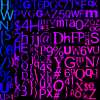As a part of two semesters research of undergraduate research at Taylor University, I development a multi-threaded tile-based software rasterizer. The pipeline rasterizes and shades four fragments in parallel using SSE instructions, and utilizes and extensive custom written SIMD optimized math library for all vertex transformations. Features supported include custom vertex and fragment shaders written purely in C++ (thanks to some operator overloading tricks), perspective correct texture mapping, clipping and backface culling, the flexibility to select different render targets, and early Z rejection. In addition, rendering order is preserved. On a Hyper-Threaded Quad-Core Intel I7 mobile processor, the rasterizer performs a full four times faster with eight threads than with one. It utilizes SDL for frame buffer, thread, and bitmap management.
Although software rendering is still considered inferior to hardware hards-down, I found it interesting how companies like Intel have been trying to revive it once again. With the direction that mainstream processor hardware is headed, it seems believable to me that we may see software rendering return to mainstream in the future. I wonder if Intel hasn't thought about replacing their IGP's in the future with dedicated cores with some additional hardware for texture filtering. That's still a few years off though, at least.
At any rate, I wrote a paper detailing the architecture of the rasterizer. You can find it here. Building a software renderer is a fun and highly educational endeavor and I recommend that anyone interested in computer graphics try it.
Click here to view the iotd
A Modern Approach to Software Rasterization
Nice work! You certainly do have focused into your topic.
The only thing I noticed from a cursory read is that you systematically misspelled 'heirarchy'.
The only thing I noticed from a cursory read is that you systematically misspelled 'heirarchy'.
Cool indeed. Did you research any of the papers/info regarding Intel's Larabee, or Nicolas Capens' work (which was bought up by Caldega).
throw table_exception("(? ???)? ? ???");
@clb
Oh my, so I did! Thank you for pointing that out. I'll fix it right away.
@Ravyne
Yes, heavily. Nick was very helpful in answering a lot of my questions, and I implemented a variation of his half-space rasterization approach detailed in his article on DevMaster. Michael Abrash's article on Larrabee rasterization was very helpful as well. The rasterizer uses a hierarchy (spelled it right this time!) of tiles and blocks that can trivially accept or reject sets of pixels.
Oh my, so I did! Thank you for pointing that out. I'll fix it right away.
@Ravyne
Yes, heavily. Nick was very helpful in answering a lot of my questions, and I implemented a variation of his half-space rasterization approach detailed in his article on DevMaster. Michael Abrash's article on Larrabee rasterization was very helpful as well. The rasterizer uses a hierarchy (spelled it right this time!) of tiles and blocks that can trivially accept or reject sets of pixels.
That looks great. I once wrote a simple rasterizer for the pocket pc. It definitely wasn't as feature rich or as polished looking as yours is but was exciting for me nonetheless. Maybe I will take another go on it sometime.
Good work.
Good work.
My current game project Platform RPG
I have indeed been against sw rasterization for a while.
However, I had to admit it has some advantages, especially when it comes to low-latency occlusion queries.
It appears we are going to see sw rasterization back into action sooner or later, for some cases, albeit perhaps not as fully complete rasterizers.
However, I had to admit it has some advantages, especially when it comes to low-latency occlusion queries.
It appears we are going to see sw rasterization back into action sooner or later, for some cases, albeit perhaps not as fully complete rasterizers.
Previously "Krohm"
Good work indeed! I've been using software rasterization for occlusion culling, where it performs a lot better than GPU occlusion culling.
My current blog on programming, linux and stuff - http://gameprogrammerdiary.blogspot.com
Nice work, thanks for sharing the paper with us!
N.B. I believe there's a niche market for reasonably-priced, well-performing software rasterization middleware these days
N.B. I believe there's a niche market for reasonably-priced, well-performing software rasterization middleware these days
it has some advantages, especially when it comes to low-latency occlusion queries.Indeed, it's been making quite a comeback as a "GPU assistant" for the past few years to get around latency problems, and on the PS3 where there's arguably more CPU power than GPU power, it's been making headway for longer than that.
. 22 Racing Series .
what performance does this rasterizer (on the mentioned platform) have? like in 1920x1080
Blog:
http://extremeistan.wordpress.com/
Stuff I wrote:
https://github.com/Yours3lf/libmymath
https://github.com/Yours3lf/linux_gl_fps
https://github.com/Yours3lf/instanced_font_rendering
https://github.com/scrawl/smaa-opengl
https://github.com/Yours3lf/gl_browser_gui
Follow me on twitter:
This topic is closed to new replies.
Advertisement
Popular Topics
Advertisement










